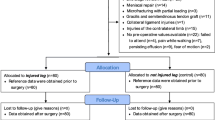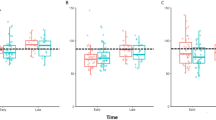Abstract
Purpose
Although changes in hamstring muscle morphology after anterior cruciate ligament reconstruction (ACLR) using a semitendinosus autograft hamstrings-gracilis (HG) of the ipsilateral limb are recognized, alterations in muscle activation patterns have not been extensively studied. The purpose of this controlled laboratory trial was therefore to monitor muscle activation levels of the medial (MH) and lateral (LH) hamstring muscles in athletes who had undergone ACLR using a HG autograft and to contrast these to activation levels demonstrated by healthy controls.
Methods
Surface electromyography (EMG) was sampled from bilateral hamstring muscles of 18 athletes 1–6 years after ACLR and 18 matched controls (CTRL) during the performance of two dissimilar exercises, both involving eccentric knee flexor activity. Peak normalized muscle activation levels were identified for MH and LH of both limbs during the performance of the Nordic Hamstring (NH) exercise and TRX® hamstring curl (TRX) exercise.
Results
A statistically significant limb by exercise interaction was found for peak activation levels of LH, due to significant interlimb differences in activation during the performance of the TRX exercise compared to more symmetrical activation during the NH (p < 0.001). A three-way interaction was found for peak activation levels of MH, due to group differences in peak muscle activation between limbs and exercise type (p = 0.025). Whereas CTRL group participants consistently favoured one limb over the other during the performance of both exercises, ACLR participants demonstrated dissimilar peak MH activation patterns between limbs during the performance of the NH exercise compared to the TRX.
Conclusions
In light of these results and considering the surgical procedure, patients who undergo ACLR using a HG autograft from the ipsilateral limb may benefit from post-operative rehabilitation that involves muscle activation and strengthening specifically targeting the MH component.




Similar content being viewed by others
References
Adams D, Logerstedt DS, Hunter-Giordano A, Axe MJ, Snyder-Mackler L (2012) Current concepts for anterior cruciate ligament reconstruction: a criterion-based rehabilitation progression. J Orthop Sports Phys Ther 42(7):601–614
Ahlen M, Liden M, Bovaller A, Sernert N, Kartus J (2012) Bilateral magnetic resonance imaging and functional assessment of the semitendinosus and gracilis tendons a minimum of 6 years after ipsilateral harvest for anterior cruciate ligament reconstruction. Am J Sports Med 40(8):1735–1741
Armour T, Forwell L, Litchfield R, Kirkley A, Amendola N, Fowler PJ (2004) Isokinetic evaluation of internal/external tibial rotation strength after the use of hamstring tendons for anterior cruciate ligament reconstruction. Am J Sports Med 32(7):1639–1643
Bencke J, Curtis D, Krogshede C, Jensen LK, Bandholm T, Zebis MK (2013) Biomechanical evaluation of the side-cutting manoeuvre associated with ACL injury in young female handball players. Knee Surg Sports Traumatol Arthrosc 21(8):1876–1881
Bourke HE, Salmon LJ, Waller A, Patterson V, Pinczewski LA (2012) Survival of the anterior cruciate ligament graft and the contralateral ACL at a minimum of 15 years. Am J Sports Med 40(9):1985–1992
Choi JY, Ha JK, Kim YW, Shim JC, Yang SJ, Kim JG (2012) Relationships among tendon regeneration on MRI, flexor strength, and functional performance after anterior cruciate ligament reconstruction with hamstring autograft. Am J Sports Med 40(1):152–162
Czamara A, Szuba L, Krzeminska A, Tomaszewski W, Wilk-Franczuk M (2011) Effect of physiotherapy on the strength of tibial internal rotator muscles in males after anterior cruciate ligament reconstruction (ACLR). Med Science Monit 17(9):CR523–CR531
Decker LM, Moraiti C, Stergiou N, Georgoulis AD (2011) New insights into anterior cruciate ligament deficiency and reconstruction through the assessment of knee kinematic variability in terms of nonlinear dynamics. Knee Surg Sports Traumatol Arthrosc 19(10):1620–1633
Delince P, Ghafil D (2012) Anterior cruciate ligament tears: conservative or surgical treatment? A critical review of the literature. Knee Surg Sports Traumatol Arthrosc 20(1):48–61
Ditroilo M, De Vito G, Delahunt E (2013) Kinematic and electromyographic analysis of the Nordic Hamstring Exercise. J Electromyogr Kinesiol 23(5):1111–1118
Eriksson K, Hamberg P, Jansson E, Larsson H, Shalabi A, Wredmark T (2001) Semitendinosus muscle in anterior cruciate ligament surgery: morphology and function. Arthroscopy 17(8):808–817
Freedman KB, Glasgow MT, Glasgow SG, Bernstein J (1998) Anterior cruciate ligament injury and reconstruction among university students. Clin Orthop Relat Res 356:208–212
Grindem H, Eitzen I, Moksnes H, Snyder-Mackler L, Risberg MA (2012) A pair-matched comparison of return to pivoting sports at 1 year in anterior cruciate ligament-injured patients after a nonoperative versus an operative treatment course. Am J Sports Med 40(11):2509–2516
Hewett TE, Di Stasi SL, Myer GD (2013) Current concepts for injury prevention in athletes after anterior cruciate ligament reconstruction. Am J Sports Med 41(1):216–224
Hewett TE, Lindenfeld TN, Riccobene JV, Noyes FR (1999) The effect of neuromuscular training on the incidence of knee injury in female athletes. A prospective study. Am J Sports Med 27(6):699–706
Hoshino Y, Fu FH, Irrgang JJ, Tashman S (2013) Can Joint Contact Dynamics Be Restored by Anterior Cruciate Ligament Reconstruction? Clin Orthop Relat Res 471:2924–2931
Iga J, Fruer CS, Deighan M, Croix MD, James DV (2012) ‘Nordic’ hamstrings exercise—engagement characteristics and training responses. Int J Sports Med 33(12):1000–1004
Li S, Chen Y, Lin Z, Cui W, Zhao J, Su W (2012) A systematic review of randomized controlled clinical trials comparing hamstring autografts versus bone-patellar tendon-bone autografts for the reconstruction of the anterior cruciate ligament. Arch Orthop Trauma Surg 132(9):1287–1297
Li S, Su W, Zhao J, Xu Y, Bo Z, Ding X, Wei Q (2011) A meta-analysis of hamstring autografts versus bone-patellar tendon-bone autografts for reconstruction of the anterior cruciate ligament. Knee 18(5):287–293
Macleod TD, Snyder-Mackler L, Axe MJ, Buchanan TS (2013) Early regeneration determines long-term graft site morphology and function after reconstruction of the anterior cruciate ligament with semitendinosus-gracilis autograft: a case series. Int J Sports Phys Ther 8(3):256–268
Nikolaou VS, Efstathopoulos N, Wredmark T (2007) Hamstring tendons regeneration after ACL reconstruction: an overview. Knee Surg Sports Traumatol Arthrosc 15(2):153–160
Onishi H, Yagi R, Oyama M, Akasaka K, Ihashi K, Handa Y (2002) EMG-angle relationship of the hamstring muscles during maximum knee flexion. J Electromyogr Kinesiol 12(5):399–406
Ristanis S, Tsepis E, Giotis D, Stergiou N, Cerulli G, Georgoulis AD (2009) Electromechanical delay of the knee flexor muscles is impaired after harvesting hamstring tendons for anterior cruciate ligament reconstruction. Am J Sports Med 37(11):2179–2186
Ruiz AL, Kelly M, Nutton RW (2002) Arthroscopic ACL reconstruction: a 5–9 year follow-up. Knee 9(3):197–200
Scanlan SF, Chaudhari AM, Dyrby CO, Andriacchi TP (2010) Differences in tibial rotation during walking in ACL reconstructed and healthy contralateral knees. J Biomech 43(9):1817–1822
Segawa H, Omori G, Koga Y, Kameo T, Iida S, Tanaka M (2002) Rotational muscle strength of the limb after anterior cruciate ligament reconstruction using semitendinosus and gracilis tendon. Arthroscopy 18(2):177–182
Snow BJ, Wilcox JJ, Burks RT, Greis PE (2012) Evaluation of muscle size and fatty infiltration with MRI nine to eleven years following hamstring harvest for ACL reconstruction. J Bone Joint Surg Am 94(14):1274–1282
Surface Electromyography for the Non-Invasive Assessment of Muscles: Recommendations for sEMG Sensors, Sensor Placement and location. www.seniam.org
Tashiro T, Kurosawa H, Kawakami A, Hikita A, Fukui N (2003) Influence of medial hamstring tendon harvest on knee flexor strength after anterior cruciate ligament reconstruction. A detailed evaluation with comparison of single- and double-tendon harvest. Am J Sports Med 31(4):522–529
Thomee R, Kaplan Y, Kvist J, Myklebust G, Risberg MA, Theisen D, Tsepis E, Werner S, Wondrasch B, Witvrouw E (2011) Muscle strength and hop performance criteria prior to return to sports after ACL reconstruction. Knee Surg Sports Traumatol Arthrosc 19(11):1798–1805
Wright RW, Gill CS, Chen L, Brophy RH, Matava MJ, Smith MV, Mall NA (2012) Outcome of revision anterior cruciate ligament reconstruction: a systematic review. J Bone Joint Surg Am 94(6):531–536
Wright RW, Magnussen RA, Dunn WR, Spindler KP (2011) Ipsilateral graft and contralateral ACL rupture at five years or more following ACL reconstruction: a systematic review. J Bone Joint Surg Am 93(12):1159–1165
Xergia SA, McClelland JA, Kvist J, Vasiliadis HS, Georgoulis AD (2011) The influence of graft choice on isokinetic muscle strength 4–24 months after anterior cruciate ligament reconstruction. Knee Surg Sports Traumatol Arthrosc 19(5):768–780
Acknowledgments
The authors would like to acknowledge Dr. Thorarinn Sveinsson, Professor at the School of Health Sciences, University of Iceland for his assistance during EMG data processing.
Author information
Authors and Affiliations
Corresponding author
Rights and permissions
About this article
Cite this article
Árnason, S.M., Birnir, B., Guðmundsson, T.E. et al. Medial hamstring muscle activation patterns are affected 1–6 years after ACL reconstruction using hamstring autograft. Knee Surg Sports Traumatol Arthrosc 22, 1024–1029 (2014). https://doi.org/10.1007/s00167-013-2696-4
Received:
Accepted:
Published:
Issue Date:
DOI: https://doi.org/10.1007/s00167-013-2696-4




